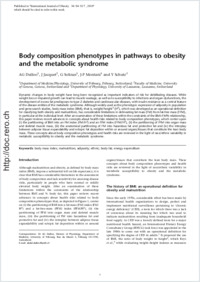Body composition phenotypes in pathways to obesity and the metabolic syndrome
- Dulloo, Abdul G. Department of Medicine/Physiology, University of Fribourg, Switzerland
- Jacquet, Jean Faculty of Medicine, University of Geneva, Switzerland
- Solinas, Giovanni Department of Medicine/Physiology, University of Fribourg, Switzerland
- Montani, Jean-Pierre Department of Medicine/Physiology, University of Fribourg, Switzerland
- Schutz, Yves Department of Physiology, University of Lausanne, Switzerland
-
2010
Published in:
- International Journal of Obesity. - 2010, vol. 34, p. S4–S17
English
Dynamic changes in body weight have long been recognized as important indicators of risk for debilitating diseases. While weight loss or impaired growth can lead to muscle wastage, as well as to susceptibility to infections and organ dysfunctions, the development of excess fat predisposes to type 2 diabetes and cardiovascular diseases, with insulin resistance as a central feature of the disease entities of the metabolic syndrome. Although widely used as the phenotypic expression of adiposity in population and gene-search studies, body mass index (BMI), that is, weight/height² (H²), which was developed as an operational definition for classifying both obesity and malnutrition, has considerable limitations in delineating fat mass (FM) from fat-free mass (FFM), in particular at the individual level. After an examination of these limitations within the constraints of the BMI–FM% relationship, this paper reviews recent advances in concepts about health risks related to body composition phenotypes, which center upon (i) the partitioning of BMI into an FM index (FM/H²) and an FFM index (FFM/H²), (ii) the partitioning of FFM into organ mass and skeletal muscle mass, (iii) the anatomical partitioning of FM into hazardous fat and protective fat and (iv) the interplay between adipose tissue expandability and ectopic fat deposition within or around organs/tissues that constitute the lean body mass. These concepts about body composition phenotypes and health risks are reviewed in the light of race/ethnic variability in metabolic susceptibility to obesity and the metabolic syndrome.
- Faculty
- Faculté des sciences et de médecine
- Department
- Département de Médecine
- Language
-
- English
- Classification
- Biological sciences
- License
- License undefined
- Identifiers
-
- RERO DOC 22815
- DOI 10.1038/ijo.2010.234
- Persistent URL
- https://folia.unifr.ch/unifr/documents/301890
Statistics
Document views: 96
File downloads:
- dul_bcp.pdf: 443
